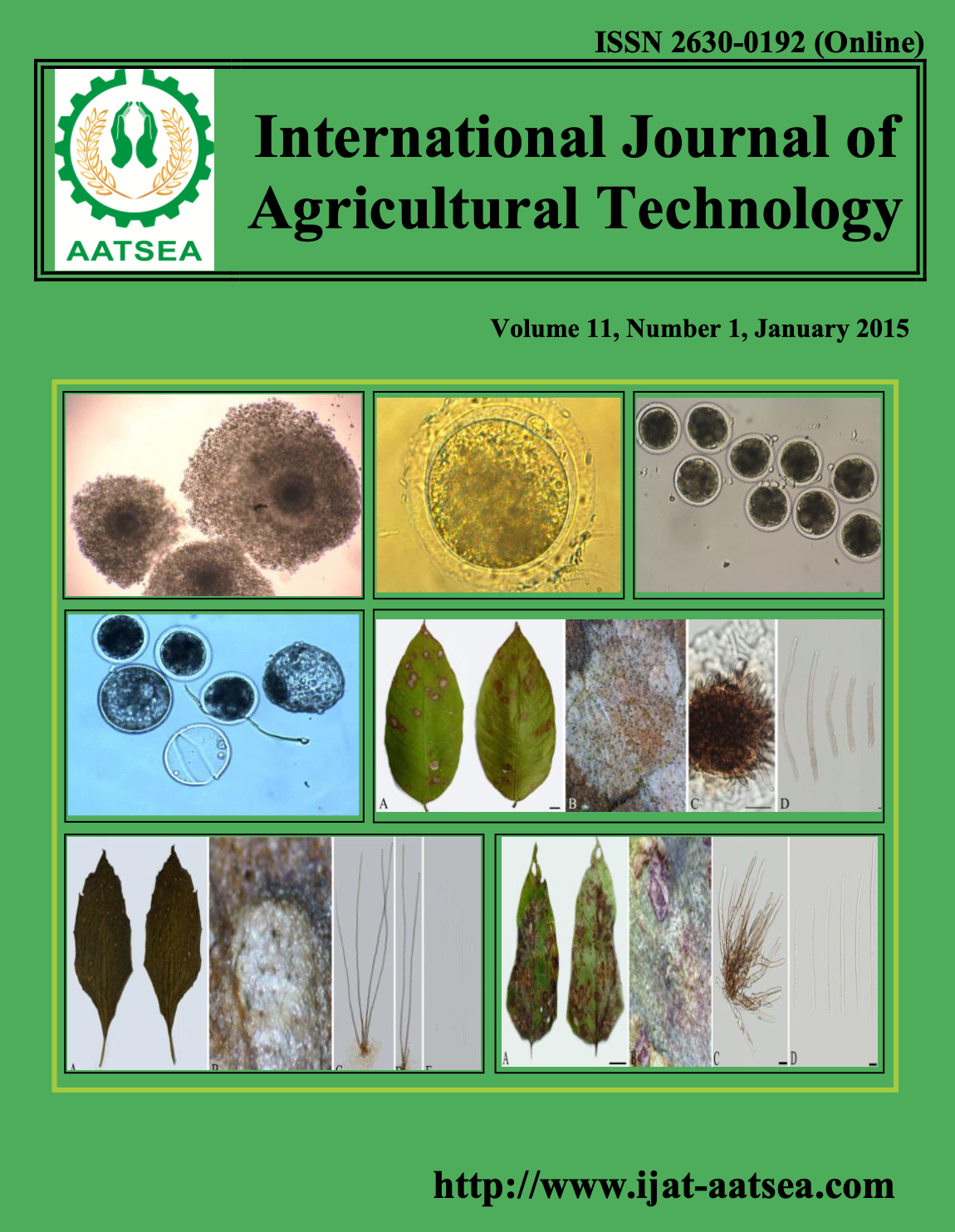Mosquito repellent from Thai essential oils against dengue fever mosquito (Aedes aegypti L.) and filaria mosquito vector (Culex quinquefasciatus Say)
Main Article Content
Abstract
Article Details

This work is licensed under a Creative Commons Attribution-NonCommercial-NoDerivatives 4.0 International License.
References
Baldacchino, F., Tramut, C., Salem, A., Lienard, E., Deletre, E., Franc, M., Martin, T., Duvallet, G. and Jay-Robert, P. (2013). The repellency of lemongrass oil against stable flies, tested using video tracking. Parasite 20:21.
Barnard, D. R. (2005). Biological assay methods for mosquito repellents. Journal of the American Mosquito Control Association 21:12-16.
Barnard, D. R., Posey, K. H., Smith, D. and Schreck, C. E. (1998). Mosquito density, biting rate and cage size effects on repellent tests. Medical and Veterinary Entomology 12:39-45.
Borah, R., Kalita, M. C., Kar, A. and Talukdar, A. K. (2010). Larvicidal efficacy of Toddalia asiatica (Linn.) Lam against two mosquito vectors Aedes aegypti and Culex quinquefasciatus. African Journal of Biotechnology 9:2527-2530.
Burdock, G. A. and Carabin, I. G. (2008). Safety assessment of Ylang-Ylang (Cananga spp.) as a food ingredient. Food Chem. Toxicol 46:433-445.
Caballero-Gallardo, K., Olivero-Verbel, J. and Stashenko, E. E. (2011). Repellent activity of essential oils and some of their individual constituents against Tribolium castaneum. Herbst. Journal of Agricultural and Food Chemistry 59:1690-1696.
Das, N. G., Baruah, I., Talukdar, P. K. and Das, S. C. (2003). Evaluation of botanicals as repellents against mosquitoes. Journal of Vector Borne Diseases 40:49-53.
Faulde, M. K., Abiez, G. and Nehring, O. (2010). Insecticidal, acaricidal and repellent effect of DEET and IR3535-impregnated bed nets using a novel long-lasting polymer-coating technique. Parasitol Research 106:957-965.
Golenda, C. F., Solberg, V. B., Burge, R., Gambel, J. M. and Wirtz, R. A. (1999). Gender-related efficacy difference to an extended duration formulation of topical N,N-diethyl-m-toluamide (DEET). The American Journal of Tropical Medicine and Hygiene Hyg 60:654-657.
Govindarajan, M. (2011). Larvicidal and repellent properties of some essential oils against Culex tritaeniorhynchus Giles and Anopheles subpictus Grassi (Diptera: Culicidae). Asian Pacific Journal of Tropical Medicine 4:106-111.
Katz, T., Miller, J. and Hebert, A. (2008). Insect repellent: historical perspectives and new developments. Journal of the American Academy of Dermatology 58:865-871.
Khandagle, A. J., Tare, V. S., Raut, K. D. and Morey, R. A. (2011). Bioactivity of essential
oils of Zingiber officinalis and Achyranthes aspera against mosquitoes. Parasitology Research 109:339-343.
Kim, J. K., Kang, C. S., Lee, J. K., Kim, Y. R., Han, H. Y. and Yun, H. K. (2005). Evaluation of repellency effect of two natural aroma mosquito repellent compounds, citronella and citronellal. Entomological Research 35:117-112.
Kumar, S., Wahab, N. and Warikoo, R. (2011). Bioefficacy of mentha piperita essential oil against dengue fever mosquito Aedes aegypti L. Asian Pacific Journal of Tropical Medicine 1:85-88.
Kumar, S. V., Mani, P., John Bastin, T. M. M. and Ravikumar, G. (2012). Mosquito larvicidal, oviposition deterrent and repellent properties of Acalypha indica L. extracts against Aedes aegypti, Anopheles stephensis and Culex quinquefasciatus. International Journal of Medicine and Biosciences 1:33-41.
Madhumathy, A. P., Aivazi, A. A. and Vijayan, V. A. (2007). Larvicidal efficacy of Capsicum annum against Anopheles stephensi and Culex quinquefasciatus. Journal of Vector Borne Diseases 44:223-226.
Manimaran, A., Cruz, M. M. J. J., Muthu, C., Vincent, S. and Ignacimuthu, S. (2013). Repellent activity of plant essential oils formulation against three diseases causing mosquito vectors. Journal of Agricultural Science and Technology 9:845-854.
Mumcuoglu, K., Galun, R., Bach, U., Miller, J. and Magdassi, S. (1996). Repellency of essential oils and their components to the human body louse, Pediculus humanus. Entomol. Experimental and Applied Acarology 78:309-314.
Mumcuoglu, K. Y., Magdassi, S., Miller, J., Ben-Ishai, F., Zentner, G., Helbin, V., Friger, M., Kahana, F. and Ingber, A. (2004). Repellency of citronella for head lice: double-blind randomized trial of efficacy and safety. The Israel Medical Association Journal 6:756-759.
Nerio, L. S., Olivero-Verbel, J. and Stashenko, E. E. (2009). Repellent activityof essential oils from seven aromatic plants grown in Colombia against Sitophilus zeamais Motschulsky (Coleoptera). Journal of Stored Products Research 45:212-214.
Pavela, R. (2008). Insecticidal properties of several essential oils on the house fly (Musca domestica L.). Phytotherapy Research 22:274-278.
Phasomkusolsil, S. and Soonwera, M. (2012). The effects of herbal essential oils on the oviposition deterrent and ovicidal activities of Aedes aegypti (Linn.), Anopheles dirus (Peyton and Harrison) and Culex quinquefasciatus (Say). Tropical Biomedicine 29:138-150.
Service, M. W. (1980). Effects of wind on the behaviour and distribution of mosquitoes and blackflies. International Journal of Biometeorology 24:359-360.
Sinthusiri, J. and Soonwera, M. (2013). Efficacy of herbal essential oils as insecticides against the housefly, Musca domestica L. The Southeast Asian Journal of Tropical Medicine and Public Health 44:188-196.
Sritabutra, D. and Soonwera, M. (2013). Repellent activity of herbal essential oils against Aedes aegypti (Linn.) and Culex quinquefasciatus (Say). Asian Pacific Journal of Tropical Disease 3:271-276.
Stuart, A. E., Brooks, C. J., Prescott, R. J. and Blackwell, A. (2000). Repellent and antifeedant activity of salicylic acid and related compounds against the biting midge, Culicoides impunctatus (Diptera: Ceratopogonidae). Journal of Medical Entomology 37:222-227.
Tawatsin, A., Wratten, S. D., Scott, R. R., Thavara, U. and Techadamrongsin, Y. (2001). Repellency of volatile oils from plants against three mosquito vectors. Journal of Vector Ecology 26:76-82.
Trongtokit, Y., Rongsriyan, Y., Komalamisra, N. and Apiwathnasorn, C. (2005). Comparative repellency of 38 essential oils against mosquito bites. Phytotherapy Research 19:303-309.
WHO (2009a). Dengue: guidelines for diagnosis, treatment, prevention, and control. Geneva: World Health Organization.
WHO (2009b). Guidelines for efficacy testing of mosquito repellents for human skins. Geneva: World Health Organization.


